 Leading Blog | Posts by Month |
 Leading Blog | Posts by Month |
09.30.22

LeadershipNow 140: September 2022 Compilation
See more on
Posted by Michael McKinney at 06:25 AM
09.29.22

Leading Thoughts for September 29, 2022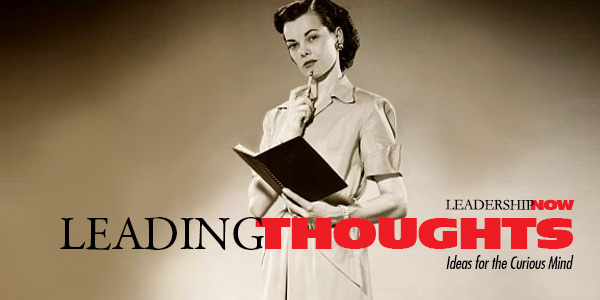
IDEAS shared have the power to expand perspectives, change thinking, and move lives. Here are two ideas for the curious mind to engage with: Paul Magnone, Christopher Frank and Oded Netzer on how we consider data in decision-making without taking the time to ask for context: “Humans tend to claim they know the absolute truth about something without appreciating the whole picture. They rely heavily on their own subjective experience to draw generalized conclusions, and they ignore other people’s limited subjective experience, even though combining their own experience with that of others would produce the most comprehensive and objectively accurate picture of something.” Source: Decisions Over Decimals: Striking the Balance between Intuition and Information
Saj-Nicole Joni and Damon Beyer on the need for leaders to create a certain amount of healthy struggle and positive change by fighting the right fights … right: “You cannot win with a team that is badly aligned. The problem is, it’s not sufficient. Achieving perfect or near-perfect alignment is not the end of the road. It’s merely the beginning Source: The Right Fight: How Great Leaders Use Healthy Conflict to Drive Performance, Innovation, and Value Look for these ideas every Thursday on the Leading Blog. Find more ideas on the LeadingThoughts index.
Posted by Michael McKinney at 07:35 AM
09.23.22

Leadership Truisms: Road-Tested Lessons for Leading During Complicated Times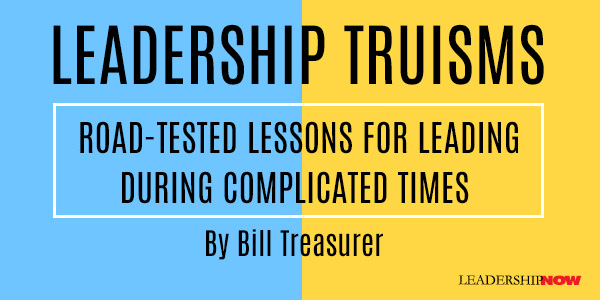
THESE are exceptionally complicated times to be a leader. The world is fraught with touchy political divisions, economic disparities, generational tensions, and racial disharmonies. Magnifying the challenges are the ever-shifting dynamics of today’s workplace. More leaders are leading remote teams across larger geographic distances, presenting unique challenges in terms of onboarding new employees, giving performance feedback, building esprit de corps, and nurturing healthy relationships. The traditional stability of consistently applied practices and processes has been upended. Now individual exceptions and customized deals are common, tailored to flexibly accommodate each person’s extenuating life realities. It’s a struggle to treat everyone fairly yet individually. Letting one person work from home three days a week to care for an immuno-compromised parent will look like good leadership to that person, but it will smack of favoritism to the healthy single person required to be onsite every day. Leaders will simultaneously be seen as exceedingly fair or unfair, depending on who benefits from policy exceptions that today’s realities require leaders to allow. Despite being a particularly challenging time to lead, leaders can use some road-tested tactics to navigate through today’s choppy waters. Leadership fitness is a function of three disciplines: leading yourself, leading others, and leading work. Leading Yourself Leadership starts with self-awareness and self-discipline. You’ve got to know what your good at, and what you’d be wise to hand off to others. You’ve got to have a deep value system that can help you weather tough people and situations. You’ve got to manage and prioritize your time. If you can’t lead yourself, what qualifies you to lead others? Here are some two-word truisms that will help you lead yourself well: Know Thyself: Leadership starts with self-awareness. Identify the formative experiences that helped shape your beliefs about leadership. Who were your earliest leadership role models? What did you learn by watching them? Also identify your sunshine and shadows: your strengths and the shadows those strengths cast when you overuse them. For example, are you a persuasive communicator? But does that cause you to often hog the limelight? Model Principles: Having deeply held values leads to inner strength. Leadership is hard and having strong inner character will help you withstand inevitable headwinds. Be clear about what you stand for — and against. List your deepest held values. Which ones do you embody? Which ones do you need to improve on? Aspire Higher: Leadership has everything to do with elevating performance — your own and others. In big ways and in small, you should be improving every day. Doing that means setting stretch goals, investing in your own development, and actively seeking out feedback from those impacted by your leadership. Practice Humility: People want to be led by leaders who are confident and humble. Always remember that you’re no better than the people you’re privileged to lead. Never be arrogant. Practice humility by asking people for their input and then listening to, and heeding, their advice. Cultivate Composure: Leaders bear a heavy burden of responsibility, which is stressful. Often that stress gets externalized in the form of anger. Don’t be a hothead. When you freak out, people lose confidence in you. Start your day with some quiet reflection. Ask yourself, what good do I want to do in the world today with my leadership influence? Leading Others Leaders can’t, and shouldn’t, do everything themselves. Your success as a leader is contingent upon how successful you help others become. Focus your leadership influence on helping each individual you work with to add more value — literally help them become more valuable. That requires investing time in their development, giving them your focused attention, and drawing out the leader in them through your coaching and feedback. Here’s how: Trust First: Trust bonds followers to leaders. Yet too many leaders fold their arms waiting for people to first prove that they can be trusted. They start from a place of skepticism and guardedness. Switch the equation. Focus first on being worthy of the trust of others. Never shade or couch the truth. Keep people updated and informed. Deliver on your commitments. Create Safety: Innovation is the lifeblood of business. People will extend themselves, experiment, and take risks if you make it safe to do so. Don’t bite people’s heads off when they make forward-falling mistakes. Don’t intimidate or stoke people’s fears. Invite feedback and thank people when they give it to you. Psychological safety is just as important as physical safety. Nurture Talent: Developing your people is a prime responsibility. Invest at least 15 minutes every two weeks with each person who reports to you. Don’t focus on the status of projects and tasks. Instead, check in with them, asking how they’re doing, how things are on the home front, and what you can do for them. The 15 minutes will dramatically strengthen the relationship and build mutual respect and loyalty. Promote Inclusion: If you care about great results, you’ll promote diversity, equity, and inclusion. Your job is to foster an environment where every person can bring their full selves to work and be totally engaged. Welcome, encourage, and foster diversity in all its expressions. Leading Work Leading yourself and others will help you ensure the final area of leadership fitness: leading work. Leaders are judged by the results they get. The whole point of leadership is to produce positive outcomes that didn’t exist before. You and your team need to deliver effectively and consistently. Leadership has everything to do with results. Here’s how to get them: Love Business: Business can be intimidating. The more experience you gain, the more business-minded you’ll become, and the less intimidating business will be. Talk to leaders you admire. Have them share the big decisions they faced and the factors they considered when facing them. Join a professional association and broaden your network. Keep an ongoing journal to document your leadership lessons. Master Management: Great managers make for great leaders. The more you master management fundamentals, the more equipped you’ll be to face complex situations. Set clear plans, goals, and milestones. Intently review progress. Equip people with the tools and resources they need. Provide coaching and feedback. Reward stellar performance. Be fiscally disciplined. Lead Up: Support your bosses’ success. Earn their respect by being candid, keeping them updated, and giving them helpful feedback. Look for stuff that they might be missing. When they give you an assignment, overdeliver. You don’t have to be a kiss-up or yes-person. You can be loyal to your boss and loyal to yourself at the same time. Despite being a particularly challenging time to be in a role that has always been challenging, if you’re disciplined about leading yourself, if you honor the responsibilities that come with leading others, and if you consistently produce great results by leading work, you’ll not only enjoy leading, but you’ll be fully fit to lead!  
Posted by Michael McKinney at 07:03 AM
09.22.22

Leading Thoughts for September 22, 2022
IDEAS shared have the power to expand perspectives, change thinking, and move lives. Here are two ideas for the curious mind to engage with: Richard Feynman on regret: “If you want to live a regret-free life, you need to stop thinking about what others think about you and your life. We spend our entire lives thinking, and in fact overthinking about people, society, teachers, and others think, who do not know our paths, our struggles, our good and bad, and unfortunately, we allow them to control our lives. It’s you who has to decide what makes you happy and pursue it accordingly. It would be stupid of you to try and stand by someone else’s expectations. Do what you feel is good for you, and right for you, In doing so, it is very obvious that you will come across failures and disappointments, but that will teach you a great deal and the best part would you, it would you and only you responsible for that.. Prof. Feynman” Source: Surely You're Joking, Mr. Feynman!
Journalist Ferris Jabr on why walking helps us think: “Perhaps the most profound relationship between walking, thinking, and writing reveals itself at the end of a stroll, back at the desk. There, it becomes apparent that writing and walking are extremely similar feats, equal parts physical and mental. When we choose a path through a city or forest, our brain must survey the surrounding environment, construct a mental map of the world, settle on a way forward, and translate that plan into a series of footsteps. Likewise, writing forces the brain to review its own landscape, plot a course through that mental terrain, and transcribe the resulting trail of thoughts by guiding the hands. Walking organizes the world around us; writing organizes our thoughts. Ultimately, maps like the one that Nabokov drew are recursive: they are maps of maps.” Source: Why Walking Helps Us Think, The New Yorker, September 3, 2014 Look for these ideas every Thursday on the Leading Blog. Find more ideas on the LeadingThoughts index.
Posted by Michael McKinney at 06:11 AM
09.20.22

Henry Kissinger on Leadership: Six Studies in World Strategy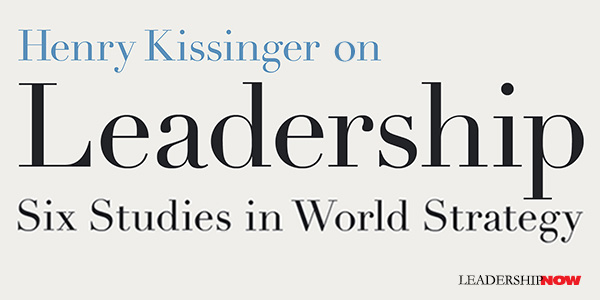
IN A SOCIETY’S transition between the past and the future, leadership is indispensable. “For strategies to inspire the society, leaders must serve as educators—communicating objectives, assuaging doubts and rallying support,” writes Henry Kissinger in Leadership: Six Studies in World Strategy. Leaders are subject to the constraints of their time, but they are also architects of the future. “Strategy arises from these constraints and uncertainty. “Strategy describes the conclusion a leader reaches under these conditions of scarcity, temporality, competition, and fluidity. In finding the way ahead, strategic leadership may be likened to traversing a tightrope: just as an acrobat will fall if either too timid or too audacious, a leader is obliged to navigate within a narrow margin, suspended between the relative certainties of the past and the ambiguities of the future.” Churchill captured these ambiguities and the need for a leader’s judgment when he wrote in The Gathering Storm; “Statesmen are not called upon only to settle easy questions. These often settle themselves. It is where the balance quivers, and the proportions are veiled in midst, that the opportunity for world-saving decisions presents itself.” Leadership is most essential during periods of transition, when values and institutions are losing their relevance, and the outlines of a worthy future are in controversy. In such times, leaders are called upon to think creatively and diagnostically. Kissinger offers an interesting discussion of transformational leaders and categorizes them into two types: the statesman and the prophet. The statesman has two tasks. First, “is to preserve their society by manipulating circumstances rather than being overwhelmed by them,” and second “is to temper vision with wariness, entertaining a sense of limits.” The prophet “treats prevailing institutions less from the perspective of the possible than from a vision of the imperative. The virtue of the prophets is that they define what appears possible. Believing in ultimate solutions, prophetic leaders tend to distrust gradualism as an unnecessary concession to time and circumstance; their goal is to transcend, rather than manage, the status quo.” All of the six of the leaders he profiles were a bit of both, but they all leaned toward the statesmanlike. He then asks if the individual makes a difference. Do they matter? He concludes yes. “They mattered because they transcended the circumstances they inherited and thereby carried their societies to the frontiers of the possible.” The six leaders, all of whom he knew personally, profiled here are:
Konrad Adenauer: The Strategy of Humility Adenauer was the first chancellor of the Federal Republic of Germany after World War II and the first leader of the Christian Democratic Union. His strategy of humility is evidenced by the fact that he acknowledged Germany’s great crimes in a way that was compatible with Germany’s unconditional surrender. He said that “the Germans could find their way toward a better future only by coming to terms with their past. His views were not always popular, but they paved the way for their full integration into Europe. “He was determined to turn submission into a virtue, and he saw that a temporary inequality of conditions was the precondition to equality of status.” Charles de Gaulle: The Strategy of Will Despite France’s humiliating defeat at the beginning of World War II, de Gaulle believed they still deserved a prominent seat at the table of world leaders. “De Gaulle presented himself as the emissary of destiny, whose task it was to reclaim France’s national greatness.” His “vision outpaced his nation’s understanding,” but his will and his “commanding, aloof, passionate, committed, visionary, ineffably patriotic” personality forged the destiny of France. Richard Nixon: The Strategy of Equilibrium Nixon “adjusted America’s role from faltering dominance to creative leadership,” and that approach guided much of the U.S. approach in the post-Cold War period. He adopted a strategy of equilibrium—a balance of power as a prerequisite for peace—to get America out of Vietnam, open relations with China, and began a peace process that would transform the Middle East. “Nixon’s strengths as a statesman resided at the two ends of geopolitical strategy: analytical rigor in design and great boldness in execution.” He was able to adjust America’s role in the world “from faltering dominance to creative leadership.” Kissinger explains, “A Nixonian flexibility, at once realistic and creative, is needed for American foreign policy” today. Anwar Sadat: The Strategy of Transcendence Sadat “inoculated himself against the conventional wisdom of his time and thus transcended ideologies that, for decades, had contorted the Middle East and bled Egypt dry.” Sadat was able to demonstrate that it was possible to transcend the pattern of recent history. “His triumphs were mainly conceptual in nature, and their mentation was truncated by his assassination,” Kissinger observes. “Sadat’s overall vision was too out of joint with that of his colleagues and contemporaries to be sustained. What survived him were the practical elements that he considered ephemeral.” Lee Kuan Yew: The Strategy of Excellence Any discussion of Lee Kuan Yew’s leadership is worth a read. He was the founder and long-time prime minister of the city-state of Singapore between 1959 and 1990. Lee’s strategy of excellence was to permeate not just government but every level of society. That excellence would knit together his society despite their differences. “Lee’s ultimate gift to his multi-ethnic people was his unremitting faith that they were their own greatest resource, that they had the capacity to unlock possibilities in themselves that they had not known existed.” The development of Singapore is a remarkable success story. Speaking of governmental policies, Lee said, “I was never a prisoner of any theory. What guided me were reason and reality. The acid test I applied to every theory or science was, would it work?” Kissinger concludes: Most significantly, Lee’s statesmanship illustrates that the best determinants of a society’s fate are neither its material wealth nor other conventional measures of power but rather the quality of its people and the vision of its leaders. Margaret Thatcher: The Strategy of Conviction Thatcher, prime minister of Britain between 1979 and 1990, defined the era in which she governed. She “labored to cast off the shackles that had limited her predecessors—particularly the nostalgia for lost imperial glories and the abiding regret of national decline. The Britain that emerged as a result of her leadership was, to the world, a newly confident nation, and to America, a valued partner in the late Cold War.” Kissinger states that “At the heart of her successes lay personal fortitude.” Fortitude in that she departed “so dramatically from the received wisdom of the time,” and she had the character to stay the “course consistently as her tough medicine drew sharp complaint from the patient.” All of the leaders profiled came from humble origins, which gave them a long-term perspective. “Their origins and experiences far from power lent them perspective, allowing them to articulate the national interest and transcend the conventional wisdom of their day.” They were steeped from their childhood in values like “personal discipline, self-improvement, charity, patriotism and self-belief.” We have let down future leaders. Our secondary schools and universities shortchange them. They offer little in the way of history or philosophy, which are the “traditional wellsprings of the statesman’s imagination.” Kissinger sadly notes that while our schools “remain very good at educating activists and technicians, they have wandered from their mission of forming citizens.” 
Posted by Michael McKinney at 08:28 PM
09.16.22

The 6 Types of Working Genius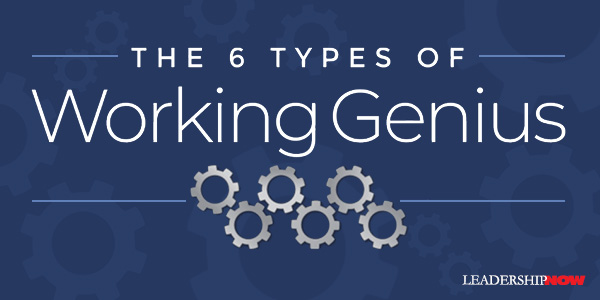
WORK is a process, and we all contribute in different ways. When the work we do is aligned with our gifts, we perform to our potential. The 6 Types of Working Genius by Patrick Lencioni is a business fable that goes behind the scenes of a team working out the frustrations they are having at work. We struggle when we are called upon to perform in ways that not consistent with what we do best. Naturally, we all have to take on tasks in ways that drain us, and that’s not a problem unless it is something we have to do all the time. If that’s the case, it leads to burnout. Judgement is similar, except that it’s what we do when we see a colleague struggle in some kind of work and incorrectly attribute their struggle to their lack of effort, intelligence, or virtue. “I don’t know why he can’t get that done. I think he just doesn’t care. Or maybe he’s just not as smart as we thought he was. Or is it possible that he just isn’t committed to the team?” We’ve all done this, and it’s dangerous and destructive. It causes people to feel hurt and rejected, and it adversely impacts teams, organizations, even families. This is a critically important issue. We should first begin by looking at the three phases of work as it forms the framework for the 6 Types. The first phase is Ideation and this is where we identify needs and propose solutions. This is the first step in any kind of work. The second phase is Activation and is about evaluating the merits of the ideas or solutions proposed during Ideation. The third phase is Implementation and this is all about getting things done—bringing it home. The 6 Types of Work Genius
Within the first phase, Ideation, we have the Genius of Wonder and the Genius of Invention. The Genius of Wonder identifies the need to improve of change. “Involves the ability to ponder and speculate and question the state of things, asking the questions that provoke answers and action. People with this genius are naturally inclined to do these things.” The Genius of Invention confirms the importance of that need and generate an idea or solution. “It is all about coming up with new ideas and solutions. People with this genius are drawn toward origination, creativity, and ingenuity in the truest sense of those words, even with little direction and context.” Moving to the second phase, Activation, we have the Genius of Discernment and the Genius of Galvanizing. The Genius of Discernment assesses the merit and workability of the idea or solution. It “is related to instinct, intuition, and uncanny judgment. People with this genius have a natural ability to assess an idea or situation, even without a lot of data or expertise. Using pattern recognition and gut feel, they are able to provide valuable advice and feedback around most subjects in a way that transcends their levels of specific knowledge or information.” The Genius of Galvanizing generates enthusiasm and action around the idea or solution. These people rally, motivate, and provoke people to take action around an idea or an initiative. “People with this genius are naturally inclined to inspire and enlist others to get involved in an endeavor.” In the last phase, Implementation, are the Genius of Enablement and the Genius of Tenacity. The Genius of Enablement initiates support and assists in the implementation of the idea or solution. This “Involves providing people with support and assistance in the way that it is needed. People with this genius are adept at responding to the needs of others without conditions or restrictions. They are naturally inclined to help others accomplish their goals and often can anticipate what people might need before they even ask.” The Genius of Tenacity commits to ensuring that the idea or solution gets completed and that results are achieved. “It is about the satisfaction of pushing things across the finish line to completion. People with this genius are not only capable of, but naturally inclined to, finish projects and ensure that they are completed according to specification.” It is helpful to see where each of the Geniuses enter the work process as it gives insight into their thinking. As depicted in the chart below, the Wonder Genius comes in at the 30,000-foot level. As we move through the work process, the focus becomes narrower down to 1000 feet for the Tenacity Genius.
After testing thousands of people for their genius, The Table Group has found that we have two geniuses, two areas of competency, and two areas of frustration. Areas of competency are activities that don’t do much for us one way or the other, and we may be quite good at them. But if we engage in them too long, we are drained if we are not also working in the areas of our genius. We need to be aware of our areas of frustration, so we don’t spend too much time engaged in them. To find out your genius take the assessment at WorkingGenius.com. There are 42 questions, and it takes about ten minutes to complete. 
Posted by Michael McKinney at 07:10 AM
09.15.22

Leading Thoughts for September 15, 2022
IDEAS shared have the power to expand perspectives, change thinking, and move lives. Here are two ideas for the curious mind to engage with: Military strategist Sun Tzu on preparation: “The art of war teaches us to rely not on the likelihood of the enemy’s not coming, but on our own readiness to receive him; not on the chance of his not attacking, but rather on the fact that we have made our position unassailable.” Source: The Art of War
American novelist Mary Flannery O’Connor on growth: “Accepting oneself does not preclude an attempt to become better.” Source: The Habit of Being: Letters of Flannery O’Connor Look for these ideas every Thursday on the Leading Blog. Find more ideas on the LeadingThoughts index.
Posted by Michael McKinney at 06:59 AM
09.13.22

The Team Lead Model of Self-Leadership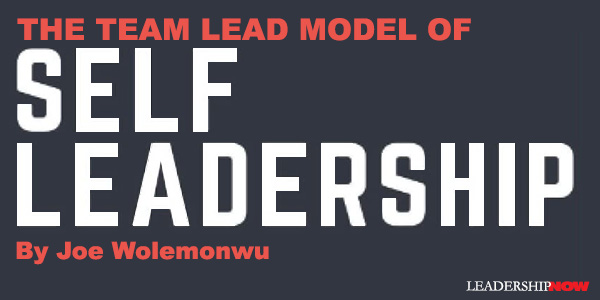
EVERY organization needs leadership. Whether you work in small enterprising entrepreneurship or a Fortune 500 conglomerate, sound leadership is required for progress. Experts will agree that effective leaders must have superior qualities, skills, and talents that influence the workforce to complete the organization’s mission efficiently and effectively. Regardless of the organization’s vision and mission statement, leadership is a fundamental requirement. The TEAM LEAD Model of Self Leadership by Joe Wolemonwu offers an eight-step model that gives every leader the tools to move their agency forward.
T.E.A.M. L.E.A.D. is an acronym for Training, Enterprising, Authenticity, Mindfulness, Listening, Empathizing, Accountability, Delegation. This model identifies eight leadership requirements, accomplishments, and skills a leader must have to be effective. In essence, this model offers a quicker rate of acceleration in all quadrants of the organization by the consistency of the leader’s conviction and commitment to excellence. A leader must possess all of the eight core T.E.A.M. L.E.A.D. attributes to be more effective. The Team Lead concept is a self-leadership approach to leading a team. Four attributes with the acronym T.E.A.M. and internal attributes the leader must possess, while the remaining four L.E.A.D. show external attributes that enable the leader to lead the team effectively. Training enhances performance, grows knowledge, makes a leader Competent, and boots productivity through learned skills. Enterprising develops a leader’s capacity to generate ideas and skills that make them creatively Resourceful. A resourceful leader always finds a way to take advantage of a situation. Authenticity gives a leader Credibility and makes people appreciate your leadership. Mindfulness creates Resilience and happiness and increases productivity. It helps regulate your emotions. It enables you to have a greater level of emotional intelligence. The second part begins with Listening. Listening helps a leader Communicate effectively and makes them more charismatic by keeping them engaged and makes them more charismatic by keeping them engaged in a conversation. It helps improve the leader’s relationships with others. Empathizing with others helps build Trust and encourages open communication and effective feedback. Accountability helps to improve Performance and enables people to be in control of their actions. Delegation helps promote Teamwork by creating a mentorship environment that supports learning and development with credible skills to grow and work effectively as a team. T.E.A.M. L.E.A.D. focuses on growing the leader internally first and having those qualities exhibited and passed on to the entire organization as a fundamental recipe for success and progress. As organizations are constantly evolving and transforming as it progresses, the same applies to the leader, who must acquire new knowledge to remain relevant and effective in leading the organization. When an organization stagnates, it dies, consequently failing to produce the goals of its mission. A leader must also intellectually grow while constantly adopting some personal attributes and skills which accentuate goodness and effective leadership. The most common measurement of a leader’s effectiveness is assessing group performance and the scope to which the goals and objectives of the group are met. The degree to which this can be measured is a strong indicator that leaders can influence their subordinates and lead them to achieve the organization’s strategic objectives. The questions that should be asked to measure a leader’s competency in accountability, for example, are as follows:
The TEAM LEAD Model of Self-Leadership serves as both a workbook and reference manual. Again, the book shares a reflection leadership concept that most leaders overlook. Reflective practice accelerates improvement in your leadership skills and enables you to better understand yourself and others. Leadership reflection makes a leader gain a better understanding of themselves (value principles, knowledge, ability, and skills), learn from past experiences, and adapt and respond to new leadership challenges. The Team Lead Model of Self-Leadership is simple to apply but requires a commitment from you to grow yourself. If leaders want to bring out the best in their team, they must first bring out the best in themselves.  
Posted by Michael McKinney at 08:53 AM
09.09.22

Queen Elizabeth II: 1926—2022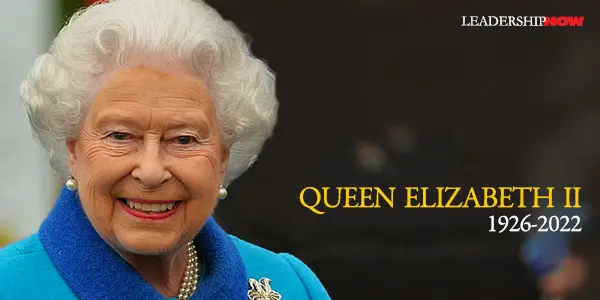
ELIZABETH ALEXANDRA MARY WINDSOR was born on April 21, 1926, during the reign of her grandfather, King George V. She died peacefully at Balmoral Castle in Scotland at age 96 on September 8, 2022 after having recently celebrated 70 years on the throne. She was the longest-lived and longest-reigning British monarch. Although the Queen shared a name with Elizabeth I they are not related. Elizabeth I was the last of the Tudor royal line, whereas the Elizabeth II is of the Windsor family. When King George V died in 1936, his son David took the throne as King Edward VIII, only to renounce it within a year to marry American divorcee Wallis Simpson. Consequently he abdicated and brother Albert was proclaimed King George VI. Upon his sudden death in 1952, he was succeeded by his elder daughter, Elizabeth II.
In 1947, 21-year-old Elizabeth married the man she had fallen in love with when she was 13: Greek-born British naval officer Philip Mountbatten, a distant cousin. Two years later, they moved to Malta, where Philip was stationed with the British Navy. Royal observers have thought that these were some of the happiest years of her life. In Malta she was able to drive her own car and mingle with other officers’ wives without the layers of security and protocol that have defined her reign. Philip died in April of 2021, just a few months shy of his 100th birthday. He and Elizabeth were married for more than 73 years, and the Queen often spoke of Philip as her “strength and stay.” Elizabeth’s coronation took place on June 2, 1953, coming to the throne as a 25-year-old mother-of-two. Winston Churchill was the first of 15 prime ministers to serve under her. She met every U.S. president during her time as Queen except Lyndon Johnson. The vast majority of Britons have never known another monarch, and she was overwhelmingly popular until her death. But it was never easy. As a leader she was authentic and a stabilizing force leading Britain through its reinvention after World War II. She enthusiastically enabled a community of nations as the Empire came to an end and bridged the gap between past and present. Through tragedies and triumphs, she kept calm and carried on.
“Criticism is good for people and institutions that are part of public life. No institution — City, Monarchy, whatever — should expect to be free from the scrutiny of those who give it their loyalty and support, not to mention those who don’t.
Posted by Michael McKinney at 08:16 AM
09.08.22

Leading Thoughts for September 8, 2022
IDEAS shared have the power to expand perspectives, change thinking, and move lives. Here are two ideas for the curious mind to engage with: Queen Elizabeth II on the value of stepping back and reflecting: “We all need to get the balance right between action and reflection. With so many distractions, it is easy to forget to pause and take stock. Be it through contemplation, prayer, or even keeping a diary, many have found the practice of quiet personal reflection surprisingly rewarding, even discovering greater spiritual depth to their lives.” Source: Queen's Christmas message, December 25, 2013
Queen Elizabeth II on courage: “Today we need a special kind of courage. Not the kind needed in battle, but a kind which makes us stand up for everything that we know is right, everything that is true and honest. We need the kind of courage that can withstand the subtle corruption of the cynics, so that we can show the world that we are not afraid of the future.” Source: 1957 Christmas Broadcast Look for these ideas every Thursday on the Leading Blog. Find more ideas on the LeadingThoughts index.
Posted by Michael McKinney at 11:56 AM
09.07.22

Build for Tomorrow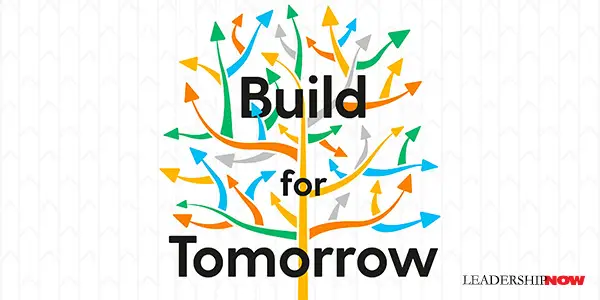
CHANGE is frequently a challenge, but in times of wide-ranging, disrupting, unavoidable change, it can be disquieting. Jason Feifer, the editor-in-chief of Entrepreneur magazine, has written a book for anyone facing an uncertain future, not just entrepreneurs. That’s most of us. Build for Tomorrow is about how we can be good at change—especially change that happens to us—sometimes more like a crisis. When faced with change, Feifer has found that we experience four phases when we are faced with change we didn’t initiate. The question is, how fast will we move from Panic! to Wouldn’t Go Back? Build for Tomorrow is designed to help us do just that. 1. Panic! Panic is natural, but staying in this stage blinds us. In this state of mind, we can’t accurately see what we are faced with. “We become impatient for solutions, do not consider all the information available, and make counterproductive decisions.” A couple of the reasons we get stuck in Panic mode is because loss is easier to see and feel than gain. We naturally extrapolate loss, so we must counter it by extrapolating the gain. We also believe that yesterday was better than today.”If we’re surrounded by the belief that yesterday was better, we’ll become less open-minded to future opportunities.” Sometimes we feel like we got where we are by sheer luck—the right place at the right time. But if we can get some perspective by asking ourselves three questions—What did I overcome? What skill set did I have then that I still have now? And what do I know now that I didn’t know then?—we can build on where we are and move forward. 2. Adaptation When confronted with change, it is easy to tell ourselves that “something is happening to me.” But that is not a productive thought because it makes us the victim. We feel out of control and acted upon. We reason that “change is scary because it seems all-encompassing and permanent,” and it will change us in all-encompassing and permanent ways, and as a result, we lose our identity—who are we anyway? But Feifer says, “We are not what we do. We are why we do it.” We need to get to the why. To adapt to the change we face, we need to widen our bands. Get out of our heads. We tend to think that everyone is thinking like us. They aren’t. Look beyond the moment. Build for tomorrow. The time to change is not “at the moment of pain—it’s at the moment of awareness.” Feifer makes the interesting point: work your next job. If we focus only on what we are doing now, we will only be qualified to do what we are doing now. But if we focus on what we could do and learn what we must, then we set ourselves up for tomorrow and the inevitable change that is coming. “Goals can be motivating but limiting. It is a direction but not a map, and it cannot define your whole journey. If you look ahead too narrowly, you’ll miss all of the promising off-ramps in your periphery.” 3. New Normal The new normal is another temporary state on our journey through life. If we are to embrace a change, we need to “identify parts of our old experience that do not change, and then use them to reframe the new opportunity in front of us.” Some things never change, and they play a part in what is changing. “You acclimate to a New Normal by seeing things as they are instead of how they were.” Try asking, “What is this for?” Instead of trying to stop or control the impending change, asking what”-is-this-for” opens us up to opportunities and gives us a new purpose and way of showing up in the world. It is a question we should constantly ask about everything we do like, what is your time for? Or What is small talk for? (“Small talk is a way to establish mutually that you’re both people who are capable of interacting.”) 4. Wouldn’t Go Back What we once thought was impossible is now the real opportunity, and we wouldn’t go back. “True opportunity exists in the unknown.” To reach our Wouldn’t Go Back moment we must reconsider the impossible. That is to say, we take another look at the things we once discarded—the things we thought were impossible, illogical, too difficult, too radical, too ridiculous to even consider—and explore whether they were the real opportunity all along. If you’re looking for a competitive advantage, ask yourself, “But Really.” On the surface, we think we know, but really there is something else going on. Only by asking but really, can we drill down to what is the fundamental difference. In your personal life, “I may be dissatisfied with my job, but really I’m being pushed to better identify what I love and how to pursue it.” Not all change is good, of course, but change is certain. And when it comes, we need to position ourselves to move through the four stages as quickly as possible. Instead of defining ourselves firmly—I am this, I do that—we must recognize that everything we do, as well as everything we are, is simply the next thing in a long line of next things. Everything is the next thing, part of a continuum of successes and failures are doors opening and closing. 
Posted by Michael McKinney at 12:19 PM
09.01.22

First Look: Leadership Books for September 2022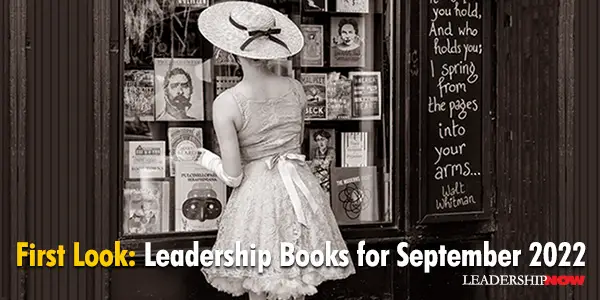
HERE'S A LOOK at some of the best leadership books to be released in September 2022. Be sure to check out the other great titles being offered this month.
The moments of greatest change can also be the moments of greatest opportunity. Adapt more quickly and use the power of change to your advantage with this guide from the editor in chief of Entrepreneur magazine and host of the Build for Tomorrow podcast. We experience change in four phases. The first is panic. Then we adapt. Then we find a new normal. And then, finally, we reach the phase we could not have imagined in the beginning, the moment when we realize that we wouldn’t go back. Build for Tomorrow is designed to accelerate that process—to help you lessen your panic, adapt faster, define the new normal, and thrive going forward. And it arrives as we all, in some way, have felt a shift in our lives. The pandemic forced a moment of collective change, and we are still being forced to make new plans and adjustments to our lives, families, and careers. Many of us will never go back, continuing to work from home, demanding higher wages, or starting new businesses.
The best leaders aren’t all found in one particular discipline, functional group, or silo. They’re found across the organizational and cultural spectrums, helping others realize their true potential through both ordinary and heroic acts of inspiration and encouragement. In The Unexpected Leader: Discovering the Leader Within You, Jacqueline M. Baker delivers an insightful and compelling exploration of how to define, refine, and elevate your leadership potential. You’ll absorb lessons from other real-life leaders and actualize the leader within you by learning to meet the demands of a rapidly changing workplace with a brand-new approach to leadership development. In the book, you’ll find examples of how stellar leadership can be found anywhere and everywhere—and in anyone—and discover new strategies for implementing the latest leadership techniques in a culturally and demographically diverse workforce.
Psychologist Woo-kyoung Ahn devised a course at Yale called “Thinking” to help students examine the biases that cause so many problems in their daily lives. It quickly became one of the university’s most popular courses. In Ahn’s class, students examine “thinking problems”―like confirmation bias, causal attribution, and delayed gratification―and how they contribute to our most pressing societal issues and inequities. Now, for the first time, Ahn presents key insights from her years of teaching and research in a book for everyone. Thinking 101 is a book that goes far beyond other books on thinking, showing how we can improve not just our own daily lives and tackle real-world problems through better awareness of our biases but also the lives of everyone around us. It is, quite simply, required reading for everyone who wants to think―and live―better.
Work relationships can be hard. The stress of dealing with difficult people dampens our creativity and productivity, degrades our ability to think clearly and make sound decisions, and causes us to disengage. We might lie awake at night worrying, withdraw from work, or react in ways we later regret—rolling our eyes in a meeting, snapping at colleagues, or staying silent when we should speak up. In Getting Along, workplace expert and Harvard Business Review podcast host Amy Gallo identifies eight familiar types of difficult coworkers—the insecure boss, the passive-aggressive peer, the know-it-all, the biased coworker, and others—and provides strategies tailored to dealing constructively with each one.
In an era of evidence-based inquiry, people need to be able to demonstrate the value of their projects credibly. But how do you do that when there isn’t an obvious measure connected to the project, like increased sales? In their new book Patti and Jack Phillips, the cofounders of ROI Institute, show how you can adopt the same methodology used by more than 6,000 organizations in seventy countries to evaluate large institutional initiatives. By following their six-step process, you can build a case for any project, process, or intervention, even so-called soft programs. The authors explain how to link your project to a meaningful business outcome, make sure your project will actually influence that outcome, identify metrics that will show if you’re making progress, collect and analyze data, and use the results to build support.
The 6 Types of Working Genius is the fastest way to help people identify the type of work that brings them joy and energy, and avoid work that leads to frustration and burnout. Beyond the personal discovery and instant relief that Working Genius provides, the model also gives teams a remarkably simple and practical framework for tapping into one another’s natural gifts. In classic Lencioni fashion, Pat brings his model to life in a page-turning fable that is as relatable as it is compelling. He tells the story of Bull Brooks, an entrepreneur, husband, and father who sets out to solve his own frustration at work and stumbles into a new way of thinking that changes the way he sees his work, his team, and even his marriage. In addition to this book, Lencioni and the Table Group have created a 10-minute assessment that helps individuals quickly identify their gifts and apply this model to themselves and their teams.
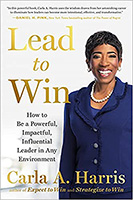 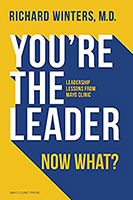 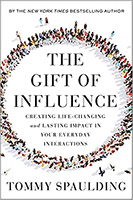 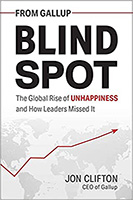
“A library is not a luxury but one of the necessities of life.” — Henry Ward Beecher
Posted by Michael McKinney at 03:01 PM

Leading Thoughts for September 1, 2022
IDEAS shared have the power to expand perspectives, change thinking, and move lives. Here are two ideas for the curious mind to engage with: Jon Gordon on the ultimate rule of positive energy: “Your positive energy and vision must be greater than anyone’s and everyone’s negativity. Your certainty must be greater than everyone’s doubt. There will always be people who don’t share your vision. There will always be the doubters who doubt, doubt, and doubt and tell you you can’t do this and you won’t be able to accomplish that. They think that dreams were meant for others but not for people like you and them. And there will even be people who don’t want you to succeed because it makes them see their own weaknesses and failures. Rather than driving their own bus they are trying to ruin everyone else’s ride.” Source: The Energy Bus: 10 Rules to Fuel Your Life, Work, and Team with Positive Energy
Wally Amos on facing your problems: “One of the realities of existence is this: If you don’t get it right the first time, life will give you another chance to master that aspect of things. And if you miss your next chance, that same challenge will again present itself to you. The process continues until you get it right. The inevitable cycle is a curse if you are running away from your problems, and a blessing if you are seeking to grow through them. In every challenge lies an opportunity.” Source: Man With No Name: Turn Lemons into Lemonade Look for these ideas every Thursday on the Leading Blog. Find more ideas on the LeadingThoughts index.
Posted by Michael McKinney at 12:02 AM
|
BUILD YOUR KNOWLEDGE


How to Do Your Start-Up Right STRAIGHT TALK FOR START-UPS 
Grow Your Leadership Skills NEW AND UPCOMING LEADERSHIP BOOKS 
Leadership Minute BITE-SIZE CONCEPTS YOU CAN CHEW ON 
Classic Leadership Books BOOKS TO READ BEFORE YOU LEAD |
|